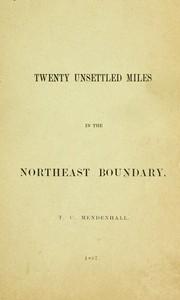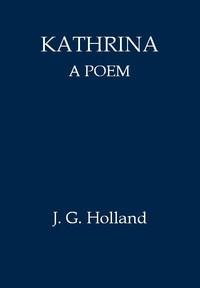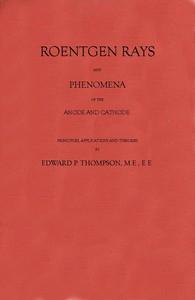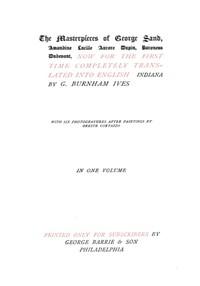Read this ebook for free! No credit card needed, absolutely nothing to pay.
Words: 10948 in 3 pages
This is an ebook sharing website. You can read the uploaded ebooks for free here. No credit cards needed, nothing to pay. If you want to own a digital copy of the ebook, or want to read offline with your favorite ebook-reader, then you can choose to buy and download the ebook.


: Twenty Unsettled Miles in the Northeast Boundary [From the Report of the Council of the American Antiquarian Society presented at the Annual Meeting held in Worcester October 21 1896] by Mendenhall Thomas C Thomas Corwin - Passamaquoddy Bay (N.B. and Me.)
Transcriber's Note:
This ebook was created in honour of Distributed Proofreaders' 20th Anniversary.
TWENTY UNSETTLED MILES IN THE NORTHEAST BOUNDARY.
TWENTY UNSETTLED MILES IN THE NORTHEAST BOUNDARY.
Very shortly after the grant of the French King in 1603, King James of England issued a charter to all of the territory in America extending from the Atlantic to the Pacific Ocean, included between the thirty-fourth and forty-sixth degrees of north latitude, covering and including the previous grant of the French King, and thus setting fairly in motion the game of giving away lands without consideration of the rights or even claims of others, in which the crowned heads of Europe delighted to indulge for a century or more. Colonization was attempted, and now one power, now another, was in the ascendant. Occasional treaties in Europe arrested petty warfare on this side, and out of it all came a general recognition of the St. Croix River as the boundary between the French possessions and those of the English. It is impossible and would be improper to go into these historical details, most of which are so generally known. It is only important to note that the province known as Nova Scotia by the one nation, as Acadia by the other, after various vicissitudes became the property of the English, and that it was assumed to be separated from the province of Massachusetts Bay by the river St. Croix.
While the latter province remained a colony, loyal to the King, and the former a dominion of the Crown, there was naturally no dispute over boundary lines. In the provisional peace treaty of 1782, between the United States and Great Britain, and in the definitive treaty of peace in 1783, it is declared that in order that "all disputes which might arise in future, on the subject of the boundaries of the said United States may be prevented, it is hereby agreed and declared that the following are and shall be their boundaries," and in this embodiment of peaceful intent is to be found the origin of international controversies which lasted more than a half a century, and which were often provocative of much bitterness on both sides. The phrase in which reference is made to the line under consideration is as follows: "East by a line to be drawn along the middle of the river St. Croix, from its mouth in the Bay of Fundy to its source." During the last days of the Revolutionary War many who had been loyal to the King during its continuance fled from the Colonies to Nova Scotia, and naturally they were not much in favor among those who had risked all in the founding of a new republic. It was believed by them that the loyalists were encroaching on the territory rightfully belonging to the province of Massachusetts, and even before the definitive treaty of peace had been proclaimed, Congress had been appealed to to drive them away from their settlement and claim what was assumed to be the property of the United States of America. There at once developed what proved to be one of the most interesting controversies in the history of boundary lines. It was discovered that although the St. Croix River had long served as a boundary, "between nations and individuals," its actual identity was unknown. The treaty declared that the line of demarcation between the two countries should be "drawn along the middle of the river St. Croix from its mouth in the Bay of Fundy," but it was found that there were several rivers debouching into this bay and that several of them had been, at one time or another, known as the St. Croix. In accordance with time-honored diplomatic practice, the English were for taking the most westerly of all these, and the Americans contended with much vigor and no small amount of justice that it was the most easterly. The St. John, a large river emptying into the Bay of Fundy, had been so long and so well known that it was out of the question. There remained three considerable streams, which, beginning with that farthest east, were known as the Magaguadavic, or popularly at the present day, the "Magadavy," the Passamaquoddy and the Cobscook, all pouring their waters into the Passamaquoddy Bay.
In the Grenville-Jay Treaty of 1794, the settling of this dispute is provided for in an agreement to appoint three commissioners, one each to be named by the respective governments and the third to be selected and agreed upon by these two, whose duty it was to "decide what river is the river St. Croix intended by the treaty," and to declare the same, with particulars as to the latitude and longitude of its mouth and its source, and the decision of these commissioners was to be final. In a supplementary treaty of 1798, this commission was relieved from the duty of determining latitude and longitude, having, for some reason or other, found difficulties in the same, or, possibly, recognizing the absurdity of defining a boundary in two distinct and independent ways. It was not until 1798 that the commissioners made their report. As is usual, indeed, almost universal in diplomatic affairs, it represented a compromise. There seems to be little doubt that the river which was called St. Croix at the time of the negotiation of the treaty of peace in 1783 was really the most easterly river or the "Magadavy," this being the testimony of the commissioners, Adams, Jay and Franklin. But at the same time it cannot be denied that the stream finally accepted as the St. Croix was the real river of that name, referred to in the traditions and treaties of two centuries, and the discovery of the remains of the French settlement on Dochet's Island quieted all doubt in the matter. England gained a decided advantage by the not-unheard-of proceeding of adhering to the letter of the treaty rather than to its spirit.
It is important to note that this partition of the islands in Passamaquoddy Bay, unfair as it unquestionably was, gave no definition of the boundary line from the mouth of the St. Croix to the sea, except inferentially. In the absence of description it must be inferred that the boundary is to be drawn so as to leave on one side all territory admitted to be American and on the other all admitted to be British. For a distance of about a half a mile the island of Campobello lies so close to the American shore that a channel, known as Lubec Channel, not more than a thousand feet in width, separates the two countries, and the thread, or deepest axis of this channel might well define the boundary. For the remaining score of miles, however, as has already been explained, the estuary is too wide, its depth too great and too uniform to afford any physical delimitation, except that based on equal division of water areas.
This ill-defined, or rather undefined boundary line has so remained for nearly eighty years. It is true that government chart-makers, both English and American, have often indicated by dotted lines their own ideas as to its whereabouts, but they have not been consistent, even with themselves, except as to making Lubec Channel a part of it, and they have had no authority except that of tradition. There has been no small amount of commercial activity among the settlements on both sides of the Bay, and a considerable proportion of the population have been, at one time or another, engaged in fishing. The customs laws of both countries, and especially the well-established fisheries regulations of the Canadians, and the activity of their fisheries police, have led to various assumptions as to the location of the boundary by one of the interested parties and to more or less tacit admission by the other. It happens that the greater part of the best fishing-grounds in the immediate vicinity of the town of Eastport is distinctly within Canadian waters, so that most of the trespassing has been done by the Americans. This has resulted in a great development of Canadian police activity, which necessarily implies assumption as to the existence and whereabouts of the boundary. The continued readiness to claim that American fishermen were trespassers, accompanied occasionally by actual arrest and confiscation, naturally led to a gradual pushing of the assumed boundary towards the American side; and there is no doubt that during the past twenty-five years, the people on that side have acquiesced in an interpretation of the original treaty which was decidedly unfavorable to their own interests. On the other hand, from Lubec Channel to the sea, through Quoddy Roads, a condition of things just the reverse of this seems to have existed. Here certain fishing-rights and localities have been stubbornly contended for and successfully held by Americans, although the territory involved, is, to say the least, doubtful. In the matter of importation of dutiable foreign goods into the United States, there existed for many years an easy liberality among the people whose occupation at one time was largely that of smuggling, for which the locality offers so many facilities. It is plain that this condition of things would give rise to no great anxiety about the uncertainty of the boundary line, although in one or two instances the activity of the Customs officers resulted in disputes as to where the jurisdiction of one country ended and that of the other began; and in at least one notable case, to be referred to at some length later, this question was adjudicated upon by the United States courts.
The question was not seriously considered by the two governments, however, from the time of the treaty of Ghent to the year 1892. It is not an uncommon belief that this part of the boundary line was considered in the famous Webster-Ashburton Treaty of 1842; and many people have unjustly held Webster responsible for the continued possession by Great Britain of the island of Campobello, which, by every rule of physiographic delimitation, ought to belong to the United States. But, as already recited, the sovereignty of this island was settled in 1817, and practically so in the original treaty of 1783. The Webster-Ashburton Treaty was apparently intended to settle the last outstanding differences between Great Britain and the United States in the matter of boundary lines, but disputes relating to them seem difficult to quiet. The treaty of 1842 carried the line only as far as the Rocky Mountains, and another in 1846 was necessary for its extension to the Pacific. Examining both of these in the light of today, there can be no doubt of the fact that the United States was seriously at fault in yielding, as she did, her rightful claims at both ends of the great trans-continental line. Enormous advantages would be hers today, if she had not so yielded; and her only excuse is that at the time of negotiation the territory involved did not seem of material value, at least when compared with her millions of acres then undeveloped.
In all of these controversies nothing was said of the little stretch of undefined boundary in Passamaquoddy Bay, and it is quite probable that those who had to do with such matters were quite unaware of its existence.
Under this convention, Hon. W. F. King, of Ottawa, Canada, was appointed commissioner on the part of Great Britain, and the writer of this paper represented the United States.
Free books android app tbrJar TBR JAR Read Free books online gutenberg
More posts by @FreeBooks


: Roentgen Rays and Phenomena of the Anode and Cathode. by Thompson Edward P Edward Pruden Anthony William A William Arnold Contributor - X-rays







